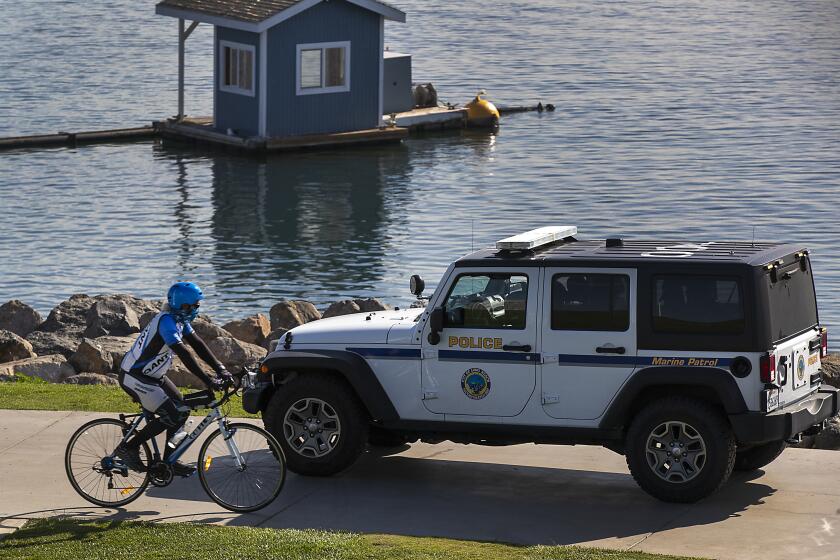Airport weather systems, runway lights were out during deadly Cessna crash in San Diego

- Share via
- Six people were aboard the jet plane, according to the Federal Aviation Administration.
- The jet plane was approaching a city-owned airport in San Diego early Wednesday morning amid dense fog and “poor conditions.”
- At least two of the people who died in the crash have been identified by their colleagues.
Runway lights and an automated system that provides weather conditions were out of operation at Montgomery-Gibbs Executive Airport before a Cessna crashed into a San Diego neighborhood amid foggy conditions, killing all its passengers, investigators revealed Friday.
As a result, the pilot did not have up-to-date weather information for the airport where he was intending to land. Dense fog blanketed the area just before the crash, according to the National Weather Service in San Diego. Six people were killed in the crash, authorities said.
Air traffic control gave the pilot information about weather conditions at an airport four miles away from where the pilot was trying to land, investigators with the National Transportation Safety Board announced on Friday.
Shortly after 3:30 a.m., the pilot and all the passengers aboard were killed when the plane plummeted into a residential neighborhood, federal investigators said.
The San Diego Medical Examiner’s Office identified three of the victims Friday: David Shapiro, 42, Emma L. Huke, 25, and Celina Marie Rose Kenyon, 35. It was not clear when the agency would release the identities of the other victims.
Dan Baker, senior air safety investigator with the NTSB, said it is still too early to determine what caused the fiery crash that left a debris field strewn across the San Diego neighborhood.
But investigators revealed Friday that an automated system that provides weather conditions to a pilot was out of operation due to a power surge at the city-owned airport.
Dense fog blanketed the area just before the crash, according to the National Weather Service in San Diego.
The air traffic control for the region provided the unidentified pilot of the Cessna Citation with weather conditions for Marine Corps Air Station Miramar, another airport about four miles away from Montgomery-Gibbs, Baker said.
“So, the pilot and the air traffic control was relying on other sources to gather weather information in the area in order to make a decision to continue the approach,” Baker said.
The pilot did not report or declare an emergency before the crash that was reported around 3:40 a.m. on Thursday.
The runway also did not have a remote-controlled light that pilots can use to assist them when landing at Montgomery-Gibbs Executive Airport, according to authorities. The jet hit high-tension power lines while approaching the airport and crashed into a home a few miles away around 3:40 a.m., according to officials. The aircraft was destroyed in a fire after the crash, Baker said.
The aircraft was not equipped with a flight data recorder, also known as a black box, which records vital data that can be used in an investigation.
“We are trying to determine at this time if the airplane was equipped with a cockpit voice recorder,” Baker said.
Maintenance records show that the aircraft did have a voice recorder installed at one point, but investigators will not have a clear answer on whether it was operating during the crash until they clear the wreckage, which is expected to happen over the weekend.
During the day pilots are able to see painted runway markings that can help them land safely at airports, but at night those indicators aren’t visible so pilots rely on runway lights, particularly during low-visibility conditions.
Randy Klatt, a member of the Foundation for Aviation Safety Advisory Board, said it’s unlikely the reduced lighting played an outsized role in the crash.
“He was right off the approach course to the runway, so that was all good,” Klatt said. “It’s just he went too low. Why was he that low? That’s another question. Did he lose focus? Was it fatigue? Was there some sort of problem with the airplane? And of course, certainly, that’s what the NTSB is going to be looking at.”
Aviation experts who spoke to The Times said it’s likely investigators will find a combination of factors that resulted in the crash.
“It was very early, it was dark and it was very foggy, so visibility was restricted,” Klatt said. “You have all those factors together.”
The crash comes amid ongoing issues at airports across the country, including a series of radar outages at Newark Liberty International airport that brought massive flight delays. Federal officials continue to investigate the January collision in Washington between a commercial jet and a military helicopter that killed 67 people.
Power outages have affected airport operations elsewhere. Earlier this year, a fire at an electric substation caused days of havoc at Heathrow airport. At the time, many major American airports reported they had emergency backup systems that would keep operations going for at least some amount of time. It’s unclear whether smaller airports like Montgomery-Gibbs have such extensive backup power supplies.
Authorities did not release the names of the pilot or the passengers who died aboard the aircraft.
Investigators will gather evidence on the scene and document the wreckage. Afterward, they will investigate the pilot’s qualifications, training and flight history, which could have played a role in the accident, Baker said.
A preliminary report is expected in the next 30 days and a final report could take one to two years, Baker said.
Here’s what we know so far:
What happened
A Cessna 550 jet, which can accommodate up to 10 people, took off from Teterboro Airport in New Jersey around 11:15 p.m. Eastern time on Wednesday and stopped for just under an hour in Wichita, Kan., according to the flight tracking site FlightAware. The aircraft was headed for Montgomery-Gibbs Executive Airport, a general aviation airport owned by the city of San Diego and located less than three miles from the crash site.
Around 3:40 a.m. Thursday, the jet made its approach to the airport. The pilot announced on the radio that the plane was three miles away from landing on Runway 28, according to a recording from LiveATC.net. The pilot did not signal any problems with the aircraft and did not issue a distress call in the recordings reviewed by The Times.
The crash was reported roughly seven minutes later, according to authorities.
Impact and poor conditions
The plane hit power lines about two miles before making impact with a house in the residential neighborhood in the Murphy Canyon area, a neighborhood that consists of military housing.
Jet fuel and debris spread across the neighborhood. At least eight people on the ground suffered minor injuries and one person was taken to the hospital, San Diego Fire-Rescue Department Assistant Chief Dan Eddy said Wednesday.
The exact measurement of where wreckage of the plane fell was still being determined by investigators.
“There’s plane everywhere,” Eddy said, calling the scene a “gigantic debris field.”
Eliott Simpson, a senior aviation accident investigator for the NTSB, said the aircraft was flying in “very poor weather conditions.”
Dense fog had rolled into the area around the time the plane was approaching the airport. Visibility was at half a mile at 3:55 a.m. and had dropped to a quarter of a mile just after 4 a.m. in the area around Marine Corps Air Station Miramar, which is just a few miles north of the crash site, according to the National Weather Service.
“We had a marine layer that was deep enough that the clouds got into some of the valleys this morning,” said Adam Roser, a meteorologist with the National Weather Service in San Diego. “This one kind of crept in from the ocean into the valley and led to some of those foggy conditions.”
Casualties
The Federal Aviation Administration confirmed that six people were aboard the jet. Officials said it was likely that nobody survived, but have not released a total number of casualties from the crash.
At least two individuals were identified by colleagues, including Dave Shapiro, co-founder of Sound Talent Group, a San Diego County-based music agency, and Daniel Williams, who posted on his Instagram on Wednesday afternoon that he was boarding the plane with Shapiro. Williams is the former drummer of the metalcore band the Devil Wears Prada. The band posted a tribute to Williams and Shapiro on its Facebook page.
Sound Talent Group confirmed to The Times that three of its employees died in the crash.
In a statement, the company said, “We are devastated by the loss of our co-founder, colleagues and friends. Our hearts go out to their families and to everyone impacted by today’s tragedy. Thank you so much for respecting their privacy at this time.”
More to Read
Sign up for Essential California
The most important California stories and recommendations in your inbox every morning.
You may occasionally receive promotional content from the Los Angeles Times.

















